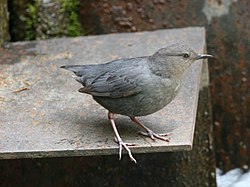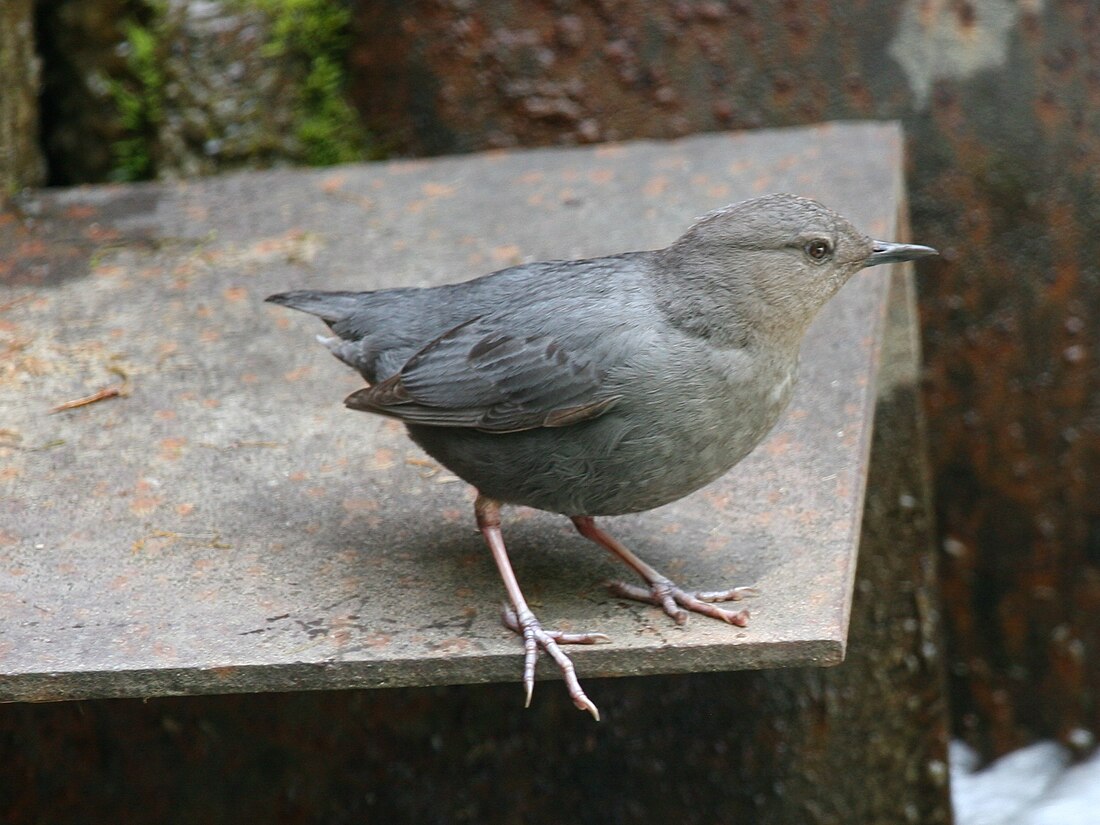American dipper
Species of bird From Wikipedia, the free encyclopedia
The American dipper (Cinclus mexicanus), also known as a water ouzel, is a semiaquatic bird species native to western North America.
| American dipper | |
|---|---|
 | |
| Scientific classification | |
| Domain: | Eukaryota |
| Kingdom: | Animalia |
| Phylum: | Chordata |
| Class: | Aves |
| Order: | Passeriformes |
| Family: | Cinclidae |
| Genus: | Cinclus |
| Species: | C. mexicanus |
| Binomial name | |
| Cinclus mexicanus Swainson, 1827 | |
 | |
| Distribution map | |
Description
It is a stocky grey bird with a head sometimes tinged with brown, and white feathers on the eyelids that cause the eyes to flash white as the bird blinks. It is 16.5 cm (6.5 in) long, has a wingspan of 23 cm (9.1 in),[2] and weighs on average 46 g (1.6 oz). The name "dipper" derives from its long legs, which it uses to bob its whole body up and down during pauses as it feeds on the bottom of fast-moving, rocky streams.
Taxonomy
The American dipper was described by the English zoologist William Swainson in 1827 based on a specimen that had been collected in Mexico by the English naturalist William Bullock. Swainson placed the new species with the dippers in the genus Cinclus and coined the current binomial name Cinclus mexicanus.[3] The type locality is Temascaltepec de González in Mexico.[4]
There are five subspecies:[5]
- C. m. mexicanus Swainson, 1827 – north and central Mexico
- C. m. anthonyi Griscom, 1930 – southeast Mexico, southwest Guatemala, east Honduras and northwest Nicaragua
- C. m. ardesiacus Salvin, 1867 – Costa Rica and west Panama
- C. m. dickermani Phillips, AR, 1966 – south Mexico
- C. m. unicolor Bonaparte, 1827 – Alaska, west Canada and west USA
Description
This species, like other dippers, is equipped with an extra eyelid called a nictitating membrane that allows it to see underwater, and scales that close its nostrils when submerged. Dippers also produce more oil than most birds, which may help keep them warmer when seeking food underwater.
The song consists of high whistles or trills peee peee pijur pijur repeated a few times. Both sexes of this bird sing year round.
Distribution and habitat
The American dipper inhabits the mountainous regions of Central America and western North America from Panama to Alaska. It is usually a permanent resident, moving slightly south or to lower elevations if necessary to find food or unfrozen water. The presence of this indicator species shows good water quality; it has vanished from some locations due to pollution or increased silt load in streams.
Behaviour and ecology
Summarize
Perspective
The American dipper defends a linear territory along streams. In most of its habits, it closely resembles its European counterpart, the white-throated dipper (Cinclus cinclus), which is also sometimes known as a water ouzel.
Breeding
The American dipper's nest is a globe-shaped structure with a side entrance, close to water, on a rock ledge, river bank, behind a waterfall or under a bridge. The normal clutch is 2–4 white eggs, incubated solely by the female, which hatch after about 15–17 days, with another 20–25 days to fledging. The male helps to feed the young. The maximum recorded age from ring-recovery data of an American dipper is 8 years and 1 month for a bird ringed and recovered in South Dakota.[6]
Feeding
It feeds on aquatic insects and their larvae, including dragonfly nymphs, small crayfish, and caddisfly larvae. It may also take tiny fish or tadpoles.
Predators
Dippers may occasionally be preyed on by predatory fish such as by brook trout, bull or Dolly Varden trout.[7][8]
History
The American dipper, previously known as the water-ouzel, was the favorite bird of famous naturalist John Muir. He dedicated an entire chapter in his book The Mountains of California to the ouzel stating "He is the mountain streams' own darling, the humming-bird of blooming waters, loving rocky ripple-slopes and sheets of foam as a bee loves flowers, as a lark loves sunshine and meadows. Among all the mountain birds, none has cheered me so much in my lonely wanderings, —none so unfailingly. For both in winter and summer he sings, sweetly, cheerily, independent alike of sunshine and of love, requiring no other inspiration than the stream on which he dwells. While water sings, so must he, in heat or cold, calm or storm, ever attuning his voice in sure accord; low in the drought of summer and the drought of winter, but never silent."[9]
Gallery
- Juvenile in Nason Creek, Washington, USA
- Subspecies C. m. ardesiacus, lithograph by Joseph Wolf, 1867
- Foraging in a stream
References
External links
Wikiwand - on
Seamless Wikipedia browsing. On steroids.



